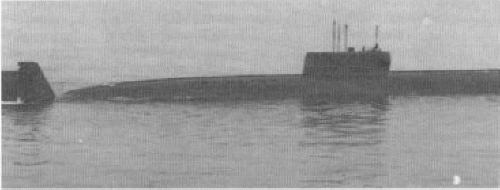
NAVYPEDIA
 Support the project with paypal
Support the project with paypal
Photo

K-162
Ships
| Name | No | Yard No | Builder | Laid down | Launched | Comp | Fate |
|---|---|---|---|---|---|---|---|
| К-162 [K-162] (ex-К-18 [K-18]), 1.1978- К-222 [K-222] | 501 | Northern Wks, Severodvinsk | 28.12.1963 | 21.12.1968 | 31.12.1969 | stricken 3.1989 |
Technical data
| Displacement standard, t |
|
|---|---|
| Displacement normal, t | 5197 / 6750 |
| Length, m | 106.9 |
| Breadth, m | 11.5 |
| Draught, m | 8.06 |
| No of shafts | 2 |
| Machinery | 2 V-5R nuclear reactors, 2 GTZA-618 geared steam turbines units |
| Power, h. p. | 80000 |
| Max speed, kts | 16 / 44.7 |
| Fuel, t | nuclear |
| Endurance, nm(kts) | practically unlimited |
| Armament | 10 x 1 P-40 Ametist SSM (10 4K66), 4 - 533 TT (bow, 12) |
| Electronic equipment | RLK-101 Albatros radar, MGK-300 Rubin, MG-509 Radian-1 sonars |
| Complement | 80 |
| Diving depth operational, m | 400 max |
Standard scale images

K-162 1969
Graphics
Project history
Project 661 seems to have been conceived about 1958 as a missile-firing counterpart to Project 705, with a titanium hull and very high speed (38kts was specified). Design work was authorised in December 1959 as part of a programme to develop a new fast submarine, new types of powerplants, and other submarine R&D. Powerplant was part of the 'second generation'. Project 661 was designed on a priority basis by TsKB-16 (Malakhit). The new Ametist missile was developed by Chelomey.
Development and construction were protracted partly because the new submarine was intended not to use existing submarine systems, and partly because of delays in supplying hull material. The concept design and TTZ were approved early in 1960. All versions developed at that time had two-reactor twin-screw propulsion, titanium hulls operable at 400m depth, missile and torpedo armament, a new high-pressure air system (400kg/cm2), a new high-pressure hydraulic system (150kg/cm2), a silver-zinc battery, and new navigation (Sigma-61) and sonar (Rubin) systems.
After model tests, the stern was divided (into a 'double-Hoggner' form) to reduce self-noise. The pressure hull was cylindrical (9m diameter amidships), but at the bow it had a figure-8 section (two 5.5m cylinders), with the cruise missiles, in individual tubes, alongside, between the pressure and outer hulls. One cylinder contained the torpedo tubes (with a power reloader); the one below contained the big sonar transducer as well as the forward battery.
Machinery was divided into two independent sets, port and starboard, each including a 3000kW turbo-generator. The submarine made 42kts on her official trials, but above 35kts she suffered from severe buffeting ('hydrodynamic noise', according to a Russian design history). After a 12-hour full-speed trial, the conning tower entry door, three hatches, and a buoy fairing were broken. During a series of experimental patrols (January 1970-Decembcr 1971), she attained 44.7kts submerged, which is still a record.
No further ships of this class were ordered due to the excessive noise level, the tactical shortcomings (unspecified) of the missile system, and because of the inadequate service lifetimes of the primary equipment. Building time was too lengthy, which probably meant that Project 661 was far too costly in terms of resources.
Modernizations
None.
Naval service
No significant events.
 HOME
HOME FIGHTING SHIPS OF THE WORLD
FIGHTING SHIPS OF THE WORLD RUSSIA / USSR
RUSSIA / USSR SUBMARINES
SUBMARINES K-162 nuclear powered cruise missile submarine (project 661) (1969)
K-162 nuclear powered cruise missile submarine (project 661) (1969)
